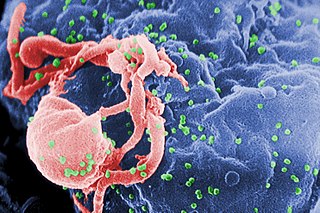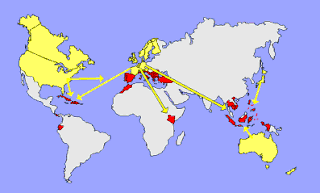
Safe sex is sexual activity using methods or contraceptive devices to reduce the risk of transmitting or acquiring sexually transmitted infections (STIs), especially HIV. "Safe sex" is also sometimes referred to as safer sex or protected sex to indicate that some safe sex practices do not eliminate STI risks. It is also sometimes used colloquially to describe methods aimed at preventing pregnancy that may or may not also lower STI risks.

Group sex is sexual activity involving more than two people. Participants in group sex can be of any sexual orientation or gender. Any form of sexual activity can be adopted to involve more than two participants, but some forms have their own names.

The AIDS epidemic, caused by HIV, found its way to the United States between the 1970s and 1980s, but was first noticed after doctors discovered clusters of Kaposi's sarcoma and pneumocystis pneumonia in homosexual men in Los Angeles, New York City, and San Francisco in 1981. Treatment of HIV/AIDS is primarily via the use of multiple antiretroviral drugs, and education programs to help people avoid infection.

HIV/AIDS originated in the early 20th century and has become a major public health concern and cause of death in many countries. AIDS rates vary significantly between countries, with the majority of cases concentrated in Southern Africa. Although the continent is home to about 15.2 percent of the world's population, more than two-thirds of the total population infected worldwide – approximately 35 million people – were Africans, of whom around 1 million have already died. Eastern and Southern Africa alone accounted for an estimate of 60 percent of all people living with HIV and 100 percent of all AIDS deaths in 2011. The countries of Eastern and Southern Africa are most affected, leading to raised death rates and lowered life expectancy among adults between the ages of 20 and 49 by about twenty years. Furthermore, life expectancy in many parts of Africa is declining, largely as a result of the HIV/AIDS epidemic, with life-expectancy in some countries reaching as low as thirty-nine years.
Men who have sex with men (MSM) are men who engage in sexual activity with other men, regardless of their sexual orientation or sexual identity. The term was created by epidemiologists in the 1990s, to better study and communicate the spread of sexually transmitted infections such as HIV/AIDS between all sexually active males, not strictly those identifying as gay, bisexual, pansexual or various other sexualities, but also for example male prostitutes. The term is often used in medical literature and social research to describe such men as a group. It does not describe any specific kind of sexual activity, and which activities are covered by the term depends on context. The alternative term "males who have sex with males" is sometimes considered more accurate in cases where those described may not be legal adults.

Bugchasing is the rare practice of intentionally seeking human immunodeficiency virus (HIV) infection through sexual activity.

Bareback sex is physical sexual activity, especially sexual penetration, without the use of a condom. The topic primarily concerns anal sex between men without the use of a condom, and may be distinguished from unprotected sex because bareback sex denotes the deliberate act of forgoing condom use.
Condom fatigue is a term used by medical professionals and safer sex educators to refer to the phenomenon of decreased condom use. It is related to decreased effectiveness of safer sex messages because people who realize the necessity of condoms still perpetuate the phenomenon. It is typically expressed as a frustration with the idea of a future filled with less sexual pleasure due to the use of condoms.
Serosorting, also known as serodiscrimination, is the practice of using HIV status as a decision-making point in choosing sexual behavior. The term is used to describe the behavior of a person who chooses a sexual partner assumed to be of the same HIV serostatus to engage in unprotected sex with them for a reduced risk of acquiring or transmitting HIV/AIDS.

Female sex tourism is sex tourism by women who travel intending to engage in sexual activities with one or more locals, including male sex workers. Female sex tourists may seek aspects of the sexual relationship not typically shared by male sex tourists, such as perceived romance and intimacy. The incidence of female sex tourism is much lower than male sex tourism, and the low number of female sex tourists makes it difficult to research this phenomenon, which has been described as "poorly understood".
The Caribbean is the second-most affected region in the world in terms of HIV prevalence rates. Based on 2009 data, about 1.0 percent of the adult population is living with the disease, which is higher than any other region except Sub-Saharan Africa. Several factors influence this epidemic, including poverty, gender, sex tourism, and stigma. HIV incidence in the Caribbean declined 49% between 2001 and 2012. Different countries have employed a variety of responses to the disease, with a range of challenges and successes.

Sexual Ecology: AIDS and the Destiny of Gay Men is a 1997 book by gay activist Gabriel Rotello, who discusses why HIV has continued to infect large numbers of gay men despite the widespread use of condoms and why a number of experts believe that new HIV infections will disproportionately affect gay men in the future. Rotello examines the origins and timeline of the AIDS epidemic, drawing on epidemiology, sociology, gay history, and ecology. His conclusion is that gay men need to reduce their number of partners and increase condom use to bring the infection rate down. Rotello's central argument derives from the epidemiological concept that sexually-transmitted epidemics are the result of three factors, sometimes called the Triad of Risk: the "infectivity" of a sexually transmitted disease (STD), or how easily it spreads; the "prevalence" of that STD in a particular group, and 3. the ‘contact rate,’ or the average number of sexual partners that people have within a particular group.

Party and play (PnP), also known as chemsex or wired play, refers to the practice of consuming drugs to enhance sexual activity. This sexual subculture involves recreational drug users engaging in high-risk sexual behaviors under the influence of drugs, often within specific sub-groups. Activities may include unprotected sex with multiple partners during sessions over extended periods, sometimes lasting days. The drug of choice is typically methamphetamine, commonly referred to as crystal meth, tina, or T. Other substances like mephedrone, GHB, GBL, ketamine, and alkyl nitrites are also used. The term slamsex is used for injection drug users.

As of 2012, approximately 1,100,000 people in Malawi are HIV-positive, which represents 10.8% of the country's population. Because the Malawian government was initially slow to respond to the epidemic under the leadership of Hastings Banda (1966–1994), the prevalence of HIV/AIDS increased drastically between 1985, when the disease was first identified in Malawi, and 1993, when HIV prevalence rates were estimated to be as high as 30% among pregnant women. The Malawian food crisis in 2002 resulted, at least in part, from a loss of agricultural productivity due to the prevalence of HIV/AIDS. Various degrees of government involvement under the leadership of Bakili Muluzi (1994–2004) and Bingu wa Mutharika (2004–2012) resulted in a gradual decline in HIV prevalence, and, in 2003, many people living in Malawi gained access to antiretroviral therapy. Condoms have become more widely available to the public through non-governmental organizations, and more Malawians are taking advantage of HIV testing services.
Sexually transmitted infections in the pornography industry deals with the occupational safety and health hazard of contracting sexually transmitted infections (STIs) by workers in the sex industry. Since the 1980s many cases of pornographic performers contracting HIV/AIDS have been reported. However, since the mid-2000s strict adherence to rigorous STI testing, and limiting sexual contact with only fellow tested performers has halted the spread of HIV and other STIs in the industry.

How to Have Sex in an Epidemic: One Approach is a 1983 manual by Richard Berkowitz and Michael Callen, under the direction of Joseph Sonnabend, to advise men who have sex with men (MSM) about how to avoid contracting the infecting agent which causes AIDS. It was among the first publications to recommend the use of condoms to prevent the transmission of STDs in men having sex with men, and has even been named, along with Play Fair!, as one of the foundational publications in the advent of modern safe sex.
Since reports of emergence and spread of the human immunodeficiency virus (HIV) in the United States between the 1970s and 1980s, the HIV/AIDS epidemic has frequently been linked to gay, bisexual, and other men who have sex with men (MSM) by epidemiologists and medical professionals. It was first noticed after doctors discovered clusters of Kaposi's sarcoma and pneumocystis pneumonia in homosexual men in Los Angeles, New York City, and San Francisco in 1981. The first official report on the virus was published by the Center for Disease Control (CDC) on June 5, 1981, and detailed the cases of five young gay men who were hospitalized with serious infections. A month later, The New York Times reported that 41 homosexuals had been diagnosed with Kaposi's sarcoma, and eight had died less than 24 months after the diagnosis was made.
Sex for fish, sometimes referred to as "fish for sex", is a phenomenon in which female fish traders engage in transactional sexual relationships with fishermen to secure their supply of fish, often out of coercion. Sex for fish is a common phenomenon in many developing countries, with the bulk of cases observed in Sub-Saharan Africa's inland fisheries. The practice is most common among economically disadvantaged women, such as single women, divorced women, or widows, who reside on or along the shores of inland fisheries.
Uganda is one of the few Sub-Saharan African countries that has adopted abstinence-only sex education as an approach of sexual education that emphasizes abstinence from sexual intercourse until marriage as the only option. Abstinence-only sex education does not include joint curriculum covering other options including safe sex practices, family planning, and is espoused as the only sure way to avoid pregnancy and sexually transmitted infections. Uganda is commonly recognized as an exemplary case of lowering the rate of HIV prevalence. Prevalence figures may have also been distorted by the lack of treatment, meaning that the percentage of infected is decreased by disproportionately early deaths. Abstinence-only sex education has been implemented and supported for this cause to a large degree in Uganda, to some controversy. Critics have questioned its effectiveness in lowering HIV/AIDS transmission. They have also highlighted discrimination, gender inequality and social stigma as the outcomes of the program in Uganda.
"Bug Chasers: The men who long to be HIV+" is a Rolling Stone magazine article written by Gregory Freeman and originally published on February 6, 2003, that describes a purportedly large group of gay men who desire to be infected with human immunodeficiency viruses (HIV). The article profiled an HIV-negative gay man—"Carlos"—who discussed his sexual fantasy of bugchasing, a practice of intentionally seeking HIV through unprotected sex with other men. Freeman interviewed two doctors for the article, who alleged that 25 percent of new HIV infections among gay men are from men who actively sought to contract the virus.











